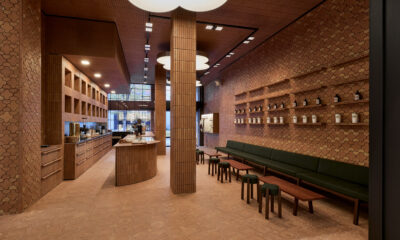Throughout its history, Domino’s Pizza Inc. (Ann Arbor, Mich.) relied more on deliveries than on in-house dining for its revenue. Needless to say, its restaurants reflected that mentality.
Interior dining areas tended to be small and narrow, with virtually no place to sit and eat (except a few chairs for those waiting on carry-out orders). Cold, stainless steel countertops blocked the view into the kitchen.
Everyone loves watching pizza being made, and the neighborhood Mom-and-Pop pizzerias put on a show. Was Domino’s trying to hide something?
In December 2009, USA Today reported Domino’s plans to entirely reinvent their pizza after a survey of consumer taste preferences among national chains showed that the company was dead last and tied with Chuck E. Cheese’s. Later, after a series of changes and ad campaigns, Domino’s was ready to reflect the reinvention of its brand in its stores.
Using a Houston Domino’s location (shown) as one of its first redesigned prototypes, Chute Gerdeman (Columbus, Ohio) created a “pizza theater” so customers could watch the pizza-making process and visually connect with their food.
“We wanted to reflect the goodness of Domino’s pizza within the space,” says Lynn Rosenbaum, vp of environments, Chute Gerdeman. “In order to do that, we had to show how the pizzas were made. The local pizzerias were getting all the credit for natural ingredients. Domino’s had all of that, but no one knew because of the way its pizza was presented.”
Advertisement
The theater encompasses the kitchen, which glows as a beacon in the space, with the rest shrouded in dim light. The awning of the theater juts out in a rich red proclaiming “Order” and “Pick Up” in blocky white letters on either side.
Linear pendant lighting directly underneath the red awning in stainless steel runs the length of the case, presenting a sense of efficiency. Under more bright lights, stainless steel ovens and work stations are in plain view of anticipating eyes. Seating was also installed at the counter so customers can get an up-close look at their pizza being made, not unlike sitting at a sushi bar.
“We allow the customer to go back into the kitchen – literally – and watch the process of pressing the dough, applying the ingredients and putting the pizza into the oven,” Rosenbaum says. “The customer becomes part of his or her pizza and feels good knowing exactly what went into it.”
To aid in the seating challenge Domino’s faced, Chute Gerdeman made sure to add seating wherever available, but mainly around the dining bar across from the pizza theater.
Wall-mounted faux pizza pans bear phrases like “What’s for Dessert?” and sit level with the dining bar. The custom wallpaper behind the pizza pans is a custom hue called “crust,” a warm shade of ochre that creates a balance between the bold reds and midnight blacks of the dining area.
The color palette is among major changes in the store, with Domino’s old blue and white still visible in certain areas of the space, such as the logo and the menu. Now, a predominance of bold red presents a sense of warmth and fun.
Advertisement
One of the finishing touches is the black chalkboard, located directly across from the gleaming white cashwrap. Its intention is to help guests connect with the brand by letting them write encouragement, comments or quotes while they wait for their food. “It was an easy and simple way to engage the customer with the store and make it their own, as well as enhance the neighborhood quality of the store,” Rosenbaum explains.
By changing its design, Domino’s also changed the way it treats customers and eat-in diners. “We want customers to feel like Domino’s is more a part of their lives; that they want to go here, it’s fun,” Rosenbaum says. “If we can create the idea that people want Domino’s to be part of their lives, then I think we’ve accomplished what we set out to do.”
Project Source List
Retailer
Domino’s Pizza Inc., Ann Arbor, Mich.
Design
Chute Gerdeman, Columbus, Ohio
Architect
CGArchitecture, Columbus, Ohio
Advertisement
General Contractor
Brazos Contractors and Development Inc., Houston
Lighting
Western Extralite, St. Louis
Furniture, Signage/Graphics
Domino’s Equipment & Supply, Ann Arbor, Mich.
Wallcoverings and Materials
Marlite FRP, Dover, Ohio


 Headlines1 week ago
Headlines1 week ago
 John Ryan2 weeks ago
John Ryan2 weeks ago
 Headlines7 days ago
Headlines7 days ago
 Headlines2 weeks ago
Headlines2 weeks ago
 Headlines1 week ago
Headlines1 week ago
 Retail Buzz3 days ago
Retail Buzz3 days ago
 Headlines1 week ago
Headlines1 week ago
 Headlines1 week ago
Headlines1 week ago






















